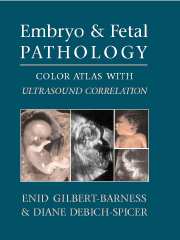Book contents
- Frontmatter
- Contents
- Foreword by John M. Opitz
- Preface
- Acknowledgments
- 1 The Human Embryo and Embryonic Growth Disorganization
- 2 Late Fetal Death, Stillbirth, and Neonatal Death
- 3 Fetal Autopsy
- 4 Ultrasound of Embryo and Fetus: General Principles
- 5 Abnormalities of Placenta
- 6 Chromosomal Abnormalities in the Embryo and Fetus
- 7 Terminology of Errors of Morphogenesis
- 8 Malformation Syndromes
- 9 Dysplasias
- 10 Disruptions and Amnion Rupture Sequence
- 11 Intrauterine Growth Retardation
- 12 Fetal Hydrops and Cystic Hygroma
- 13 Central Nervous System Defects
- 14 Craniofacial Defects
- 15 Skeletal Abnormalities
- 16 Cardiovascular System Defects
- 17 Respiratory System
- 18 Gastrointestinal Tract and Liver
- 19 Genito-Urinary System
- 20 Congenital Tumors
- 21 Fetal and Neonatal Skin Disorders
- 22 Intrauterine Infection
- 23 Multiple Gestations and Conjoined Twins
- 24 Metabolic Diseases
- Appendices
- Index
3 - Fetal Autopsy
Published online by Cambridge University Press: 23 February 2010
- Frontmatter
- Contents
- Foreword by John M. Opitz
- Preface
- Acknowledgments
- 1 The Human Embryo and Embryonic Growth Disorganization
- 2 Late Fetal Death, Stillbirth, and Neonatal Death
- 3 Fetal Autopsy
- 4 Ultrasound of Embryo and Fetus: General Principles
- 5 Abnormalities of Placenta
- 6 Chromosomal Abnormalities in the Embryo and Fetus
- 7 Terminology of Errors of Morphogenesis
- 8 Malformation Syndromes
- 9 Dysplasias
- 10 Disruptions and Amnion Rupture Sequence
- 11 Intrauterine Growth Retardation
- 12 Fetal Hydrops and Cystic Hygroma
- 13 Central Nervous System Defects
- 14 Craniofacial Defects
- 15 Skeletal Abnormalities
- 16 Cardiovascular System Defects
- 17 Respiratory System
- 18 Gastrointestinal Tract and Liver
- 19 Genito-Urinary System
- 20 Congenital Tumors
- 21 Fetal and Neonatal Skin Disorders
- 22 Intrauterine Infection
- 23 Multiple Gestations and Conjoined Twins
- 24 Metabolic Diseases
- Appendices
- Index
Summary
The normal anatomy of the adult and child are similar; however, the perinatal autopsy is significantly different. The variety and complexity of the congenital anomalies found in perinatal and fetal autopsies is endless and the prosector must be prepared to spend the necessary time demonstrating these anomalies. This detailed procedure can be altered to preserve any anomaly encountered without deforming the body itself. Most of the anomalies found in this population never survive to adulthood. Together with the clinical information this meticulous examination provides the necessary information to educate the families about future pregnancies.
PLACENTAL CHANGES AFTER FETAL DEATH
After the intrauterine death of the fetus, the placenta remains vital until it is expelled. However, changes occur that resemble vascular insufficiency but are diffuse, affecting fetal structure and all villi (Figure 3.1). Focal lesions suggest a preexisting abnormality (Tables 3.1).
Fetal death results in complete interruption of the fetal circulation. Vascular spaces within the villi are empty and collapsed. Within weeks, ingrowth of fibroblasts ultimately completely obliterate the vessels. Thrombosis does not occur and if present indicates preexistent pathology.
Calcificationmay be observed in addition to fibrosis as a postmortemchange within villi. It presents as fine granules deposited along the basal membrane of the trophoblast, sometimes almost in linear fashion. The fine granules contrast with the coarse deposits that sometimes occur in villi during physiological maturation. After fetal death, there are excessive syncytial knots that are diffuse. Primary vascular insufficiency is usually focal.
- Type
- Chapter
- Information
- Embryo and Fetal PathologyColor Atlas with Ultrasound Correlation, pp. 45 - 74Publisher: Cambridge University PressPrint publication year: 2004
- 1
- Cited by

